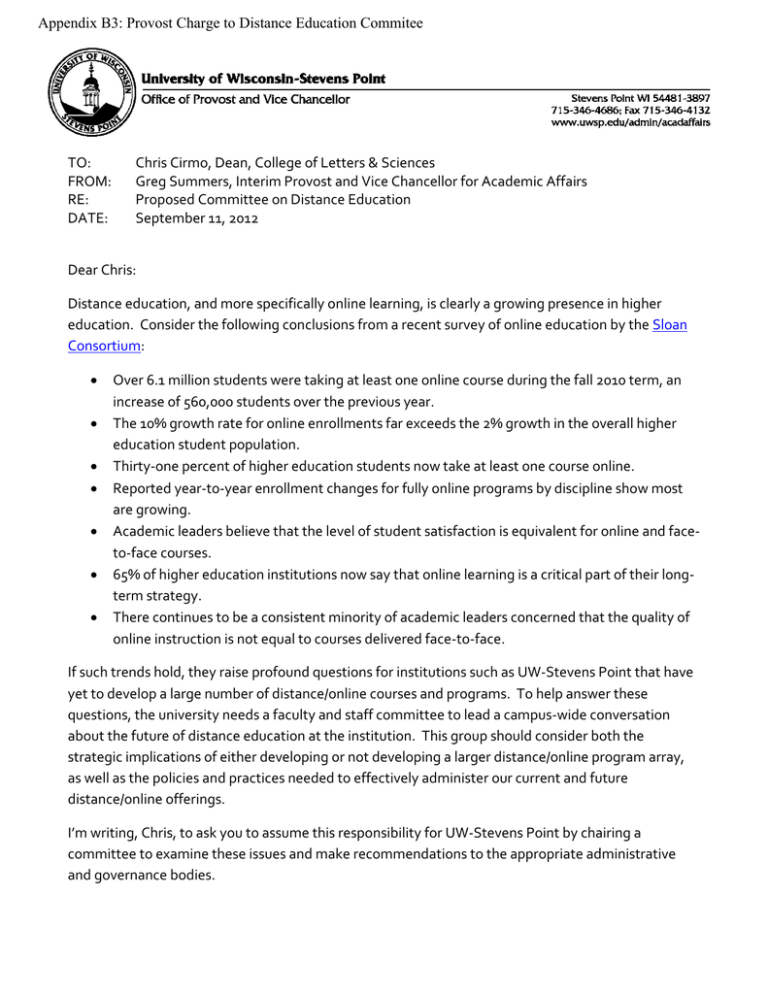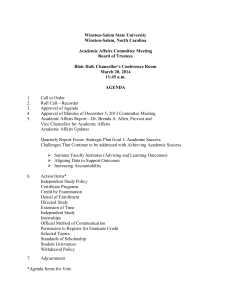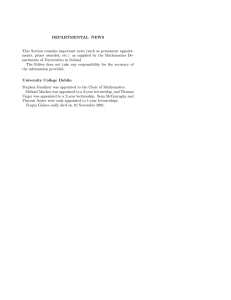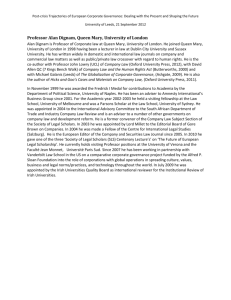Appendix B3: Provost Charge to Distance Education Commitee TO:
advertisement

Appendix B3: Provost Charge to Distance Education Commitee TO: FROM: RE: DATE: Chris Cirmo, Dean, College of Letters & Sciences Greg Summers, Interim Provost and Vice Chancellor for Academic Affairs Proposed Committee on Distance Education September 11, 2012 Dear Chris: Distance education, and more specifically online learning, is clearly a growing presence in higher education. Consider the following conclusions from a recent survey of online education by the Sloan Consortium: • • • • • • • Over 6.1 million students were taking at least one online course during the fall 2010 term, an increase of 560,000 students over the previous year. The 10% growth rate for online enrollments far exceeds the 2% growth in the overall higher education student population. Thirty-one percent of higher education students now take at least one course online. Reported year-to-year enrollment changes for fully online programs by discipline show most are growing. Academic leaders believe that the level of student satisfaction is equivalent for online and faceto-face courses. 65% of higher education institutions now say that online learning is a critical part of their longterm strategy. There continues to be a consistent minority of academic leaders concerned that the quality of online instruction is not equal to courses delivered face-to-face. If such trends hold, they raise profound questions for institutions such as UW-Stevens Point that have yet to develop a large number of distance/online courses and programs. To help answer these questions, the university needs a faculty and staff committee to lead a campus-wide conversation about the future of distance education at the institution. This group should consider both the strategic implications of either developing or not developing a larger distance/online program array, as well as the policies and practices needed to effectively administer our current and future distance/online offerings. I’m writing, Chris, to ask you to assume this responsibility for UW-Stevens Point by chairing a committee to examine these issues and make recommendations to the appropriate administrative and governance bodies. 1. Committee Structure and Function: a. The Committee will function as an ad hoc committee advisory to both the Provost and the university’s Strategic Planning Committee. b. Even though the committee will not formally be a part of faculty governance, the group should consult closely with governance on a regular basis, especially concerning recommendations that may need Faculty Senate approval. c. Recommended Composition: i. The Associate Vice Chancellor for Teaching, Learning, and Academic Programs (ex-officio) ii. One representative from Enrollment Management appointed by the AVC for Enrollment Management iii. One Dean (on a revolving basis or as per interest dictates) iv. One faculty member representing each College appointed by respective Dean v. One faculty member at-large appointed by Committee Chair (here, you might consider the UWSP faculty representative to the UW System Flexible Degree Committee) vi. One representative from Information Technology appointed by the Director of IT, preferably someone involved with instructional design vii. One-to-two representatives from relevant governance committees, such as the Academic Affairs Committee or the University Technology Committee viii. One representative from Continuing Education, appointed by the Executive Director of CE ix. One student representative appointed by the Student Government Association x. One representative from Student Affairs appointed by the Vice Chancellor for Student Affairs, preferably someone representing student support services 2. Committee Charge: a. Identify/support what role distance education (including online/hybrid course offerings) might play within UWSP’s larger strategic plan / academic plan: i. Fit with: Partnership for Thriving Communities ii. Fit with: Existing Programs (Collaborative Degree Program, American Studies, CNR, Education, etc.) iii. Enhance: Emerging partnerships with other online initiatives, including: the UW System Flexible Degree, UW-Extension (HWM, HIMT), and other UW System partners (BAAS with UW-Marshfield) b. Identify current (existing) distance (online/hybrid) educational opportunities at UWSP: i. Ensure a centralized inventory of such offerings o Form of listings in Timetable / Catalog c. d. e. f. ii. Report to (advertise on) the UW System websites o Coordinating with Continuing Education / University Relations and Communications / UW Extension Ensure/support quality of distance/online/hybrid course offerings: i. Support faculty development / instructional design o Curricular redesign / pedagogical innovation o Train-the-trainer model (faculty training other faculty) o Internal “list-serve” to communicate with campus community o Collect information regarding long-term contributions / effectiveness / sustainability ii. Develop logistical aspects of distance/online/hybrid course delivery: o Peer review process o Online student course evaluations o Assessment of student learning iii. Function: a recommending body, providing advice about required “credentials” (training) for offering online courses. Ensure that meaningful student support services are provided: i. Adult, non-traditional, place-bound learners ii. Textbooks, ID cards, library access, disability services, and other campus support iii. Advising, tutoring, writing lab, accessibility accommodations Make recommendations regarding policies / guidelines: i. Department-based staffing and “load” considerations ii. Scheduling and facilities iii. Program Integrity / State Authorizations / distance delivery (HLC) o Including coordination with UW System efforts Develop an Assessment Plan with desired outcomes assessments pertaining to the long-term viability of the programs on campus. Perhaps an Assessment Plan for all Distance/On-line Education. 3. Alignment with University Strategic Plan a. Student-centered: Online distance education encourages the transition from teachercentered learning to student-centered learning, or "learner-centered" teaching. Adaptive learning technology employed in online teaching is able to address specific student needs. b. Critical thinking, creativity, and lifelong learning: Online and blended distance education courses address the needs of today's traditional and non-traditional learners. One can argue that these learner labels are becoming a relic of the past as our culture embraces life-long learning. A culture of life-long learning is necessary to meet the ever-changing challenges of a job market increasingly influenced by the global economy. c. Professional preparation: Today and in the future much professional development is and will be conducted online. Regional and multinational companies increasingly use online learning for professional development. Providing opportunities for online learning while attending university prepares students for this kind of future training. d. Community involvement and outreach: Distance education allows the university to come to its constituents rather than the constituents having to come to the university for personal and professional enrichment and collaboration. e. Ecological stewardship: Recent research shows that online distance education is ecologically sound. Environmental impacts of transportation and energy use by residential classes is reduced, especially for a university that is already recognized as a leader in alternative energy use and sustainability. Please note that many of the above items could be addressed if the Committee develops a comprehensive “handbook” for distance/online/hybrid educational offerings, similar to that developed by UW-La Crosse: http://www.uwlax.edu/online/handbook.pdf. I suggest that the Committee give strong consideration to this idea.



